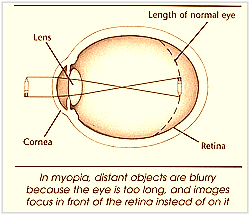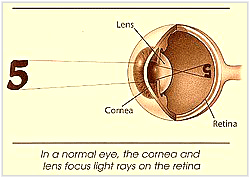 |
||||
|
||||
|
Refractive Errors: The Most Common Eye Problem
For our eyes to be able to see, light rays must be bent or "refracted" so they can focus on the retina, the nerve layer that lines the back of the eye. The cornea and the lens refract light rays. The retina receives the picture formed by these light rays and sends the image to the brain through the optic nerve.
What are Refractive Errors?A refractive error means that the shape of your eye doesn't refract the light properly, so that the image you see is blurred. While refractive errors are called eye disorders, they are not diseases. There are 4 types of refractive errors: myopia, hyperopia, astigmatism, and presbyopia.  Myopia (nearsightedness)A myopic eye is longer than normal, so that the light rays focus in front of the retina. Close objects look clear but distant objects appear blurred. Myopia is inherited and is often discovered in children when they are eight to twelve years old. During the teenage years, when the body grows rapidly, myopia gets worse. Between the ages of 20 and 40, there is usually little change. If the myopia is mild, it is called low myopia. Severe myopia is known as high myopia. If you have high myopia, you have a higher risk of detached retina. It is important to have regular eye examinations by an ophthalmologist (medical eye doctor) to watch for any changes in the retina. If the retina does detach, a surgical operation is the only way to repair it.  Hyperopia (farsightedness)A hyperopic eye is shorter than normal. Light from close objects, such as the page of a book, cannot focus clearly on the retina. Like nearsightedness, farsightedness is usually inherited. Babies and young children tend to be slightly hyperopic. As the eye grows and becomes longer, hyperopia lessens. Astigmatism (distorted vision)The cornea is the clear front window of the eye. A normal cornea is round and smooth, like a basketball. When you have astigmatism, the cornea curves more in one direction than in the other, like a football. Astigmatism distorts or blurs vision for both near and far objects. It's almost like looking into a funhouse mirror in which you appear too tall, too wide or too thin. You can have astigmatism in combination with myopia or hyperopia. Presbyopia (aging eyes)When you are young, the lens in your eye is soft and flexible. The lens of the eye changes its shape easily, allowing you to focus on objects both close and far away. After the age of 40, the lens becomes more rigid. Because the lens can't change shape as easily as it once did, it is more difficult to read at close range. This perfectly normal condition is called presbyopia. You can also have presbyopia in combination with myopia, hyperopia or astigmatism. How are Refractive Errors Treated?Eyeglasses or contact lenses are the most common methods of correcting refractive errors. They work by refocusing light rays on the retina, compensating for the shape of your eye. Refractive surgery is also an option to correct or improve your vision. These surgical procedures are used to permanently adjust your eye's focus by reshaping the cornea, or front surface of your eye. There is no scientific evidence that eye exercises, vitamins or pills can prevent or cure refractive errors. EyeglassesGlasses are an easy method to correct refractive errors. They can also help protect your eyes from harmful light rays, such as ultraviolet (UV) light rays. A special coating that screens out UV light is available when you order your glasses. Bifocals are glasses that are used to correct presbyopia. They have a correction for reading on the bottom half of the lens and another for seeing at a distance on the top. Trifocals are lenses with three different lens corrections in one set of eyeglasses. If you don't need correction for seeing at a distance, you can receive a prescription for reading glasses or buy them over-the-counter to correct presbyopia. No exercise or medication can reverse presbyopia. You will probably need to change your prescription from time-to-time between the ages of 40 and 60, because your lens will continue to lose flexibility. Contact LensesThere are now a wide variety of contact lenses available. The type that is best for you depends on your refractive error and your lifestyle. If you want to wear contact lenses, discuss the various options with your ophthalmologist. You may have heard of a process called orthokeratology to treat myopia. It uses a series of hard contact lenses to gradually flatten the cornea and reduce the refractive error. Improvement of sight from orthokeratology is temporary. After the use of the lenses is discontinued, the cornea returns to its original shape and myopia returns. Refractive SurgeryPhotorefractive keratectomy (PRK) The excimer laser is used to reduce myopia, astigmatism and hyperopia in a procedure called photorefractive keratectomy (PRK). Using an invisible, high energy light, the laser precisely sculpts the cornea. No surgical blades are used in PRK. Laser in-situ keratomileusis (LASIK) LASIK is a combined microsurgical and excimer laser procedure to correct myopia and astigmatism. In LASIK, a highly specialized instrument (microkeratome) is used to make a thin flap in the cornea. This flap is folded back, and excimer laser is then applied to the cornea under the flap to correct myopia and astigmatism. The flap is then replaced and allowed to heal back into position. There are no stitches used in this procedure. Radial keratotomy (RK) Radial keratotomy is a surgical operation to improve myopia by changing the curve of the cornea over the pupil. The surgeon makes several deep incisions (keratotomies) in the cornea in a radial, or spoke-like, pattern. The incisions flatten out the cornea and shorten the distance light rays must travel to the retina. Astigmatic keratotomy (AK) Astigmatic keratotomy is a microsurgical procedure. The surgeon makes deep incisions in the cornea (usually one or two) in a curvillinear pattern. The incisions flatten the areas of the cornea that are too steeply curved. Complications and side effects Refractive surgery is elective surgery so it is very important to make an informed decision, should you decide to have it. Complications and side effects of these procedures include:
What is the best method of correcting refractive errors?There is no best method for correcting refractive errors. The most appropriate correction for you depends on your eyes and your lifestyle. You should discuss your refractive errors and your lifestyle with your ophthalmologist to decide on which correction will be most effective for you. Copyright © American Academy of Ophthalmology |
Copyright ©2006 H.J. Wisnicki, MD All Rights Reserved

